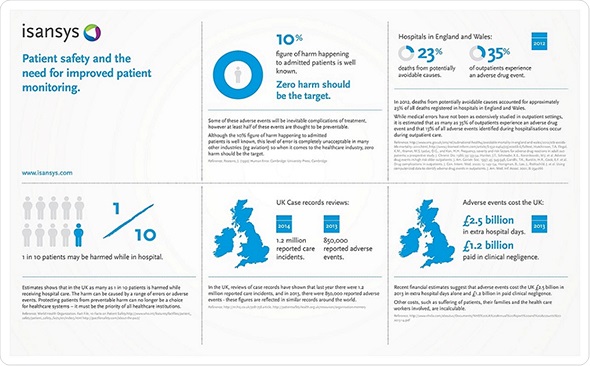There is overwhelming evidence that significant numbers of patients are harmed from the healthcare they receive resulting in permanent injury, increased length of stay in hospital or even death.

It is now widely accepted that 1 in 10 patients admitted to hospital will be unintentionally harmed in some way. This harm can be caused by a range of errors or adverse events.
Some of these adverse events will be inevitable complications of treatment, however, at least half of these events are thought to be preventable.
Although the 10% figure of harm happening to admitted patients is well known, this level of error would be completely unacceptable in many other industries (eg aviation), so when it comes to the healthcare industry, zero harm should be the target.
The infographic attached provides a number of very sobering facts about the sheer scale of the problems resulting from patient safety incidents in UK hospitals.
A deeper insight into the extent of the situation, and the best ways to solve these problems for patients in the ward and at home, can be found in Isansys Lifecare Ltd’s latest whitepaper: Improving Patient Safety through improved remote monitoring.
To find out more about how Isansys’ second generation systems can improve patient safety both within hospital settings and at home, or to book a free demonstration, please log into www.isansys.com or call 01235 436229.
Wearable Sensor Technology in Healthcare from Isansys
About Isansys Lifecare Limited
Isansys Lifecare is a new generation healthcare company that provides patient surveillance and monitoring services built on an innovative, low cost and scalable platform
We work with leading healthcare professionals and healthcare organisations operating in a wide range of healthcare settings, who want to employ new patient monitoring technologies and methods to improve patient outcomes and reduce costs.
Isansys’ ‘Vitals as a Service’™ clinical solution provides continuous real-time information for automated patient surveillance, for early warning scores and track and trigger indicators, and for predicting adverse events. Through its low cost and highly scalable architecture, the LifeTouch-based system offers the opportunity for continuous surveillance of all patients regardless of whether they are in hospital, other care facilities, or at home. For the first time, healthcare providers can not only cost-effectively improve patient safety and enhance clinical outcomes, but also massively reduce costs associated with avoidable patient deterioration, medical errors, readmissions to intensive care wards, and admissions (and readmissions) to hospital.